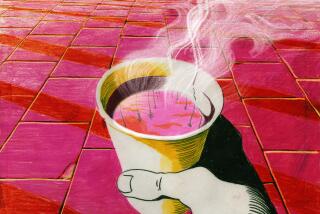Kitchen Kitsch Goes Highbrow: CSUN Salutes Art of Toasting
- Share via
Starting March 13, 43 different types of toasters will be on display in Northridge.
This event will not be at the Broadway, J.C. Penney or any other department store. It neither marks the debut of a new concept in retro diners nor does it kick off a new retail concept a la “Toasters R Us” or “Toasters ‘n Dinettes.”
The unadorned, off-the-shelf toasters will be exhibited in an art gallery.
“We’re not saying that these are high art,” Philip Morrison, curator of the “The Toaster” show coming to the Cal State Northridge Art Gallery, said as he stood in a workroom amid the toasters being readied for display. “But I think that they do reflect architecture. They are like little buildings.”
The man who collected all these toasters isn’t willing to go quite that far. “I think that they can be used as an index in thinking about American design,” said Joseph Krause of Long Beach, who teaches design and other topics at Cal State Long Beach. “But I’m not sure they should be given more importance than that. Any aesthetic quality that gets assigned to them happens because some people simply like the way they look.”
Krause is one of those people.
“I think they are damned interesting,” said Krause, 65. “I think they are really neat.”
That assessment is tough to dispute. The stars of the exhibit with two subtitles--”A Design Metaphor: 1905-1945” and “From Burned Fingers to Perfect Toast”--are whimsical variations on the theme of a basic kitchen appliance. A Toastmaster pop-up toaster circa 1930 has a gleaming Art Deco design on its side that would look appropriate in the classic buildings of the period. Others come in a variety of shapes and sport imaginative geometric designs stamped into the metal or have a sleek streamlined look. One 1910 flat-top model is supported by Grecian columns and has all the ambiance of a funeral pyre.
Krause began collecting them in about 1958 in the aftermath of a fire that destroyed the house that he and his wife shared on Mount Washington.
“I don’t like store-bought bread and my wife is a wonderful bread baker,” he said. But he could not find a toaster that would accommodate anything other than the standard thickness of store-bought sliced bread. “The sleek pop-up toaster models that were popular in the ‘50s would only accommodate thinly sliced bread. Soon bread bakers put out only bread sliced thin enough to fit into them and eventually the toaster makers didn’t have to worry about accommodating anything else.”
Krause found a solution and a new hobby in a St. Vincent De Paul thrift shop near Chinatown. “I was looking for 78 records, which I collected at the time, when I saw this neat old-time toaster that could adjust to different sized slices. It worked fine. I think I paid 10 or 15 cents for it.”
The type he found had a flap-type holder that closed over the bread and held it close to the electric filaments. The flap had to be turned to toast both sides of a piece of bread, but Krause was more than willing to put up with the inconvenience.
In looking at other toasters when he visited thrift shops, he noticed that this flap-type arrangement came in a variety of designs in the years before the product was standardized. He began to buy the models that caught his eye and had plans to include them in a book that he would write on American design. The toasters would show how the look of everyday products evolved.
His two favorites are a sleek model with black handles that Krause characterizes as having a “classical form” and an ornate toaster that flips the toast over with the touch of a button. The latter is shaped like a heart and is called the Sweetheart model. “My wife gave it to me one year for Valentine’s Day,” he explained.
Eventually Krause became involved in other projects and dropped the idea of doing the book, but he kept on collecting toasters until about 15 years ago. “It was sort of fun,” he said, and they were not expensive. Krause said he paid less than a dollar for most of the toasters in his collection. “But they do take up a lot of space.”
When he and his wife moved into a former ballroom atop an old Long Beach hotel and renovated it into a unique living space, there was room for neither his toasters nor the many waffle irons and other vintage electrical appliances that he had gathered.
He happened to be going through his boxes of stuff when Morrison, who knew about the collection, called with the idea of mounting a toaster show.
These days, Krause said, he and his wife use a toaster oven when they desire well-done toast. But it’s not as if he is completely deserting his old hobby. “I got that toaster oven for $4 at a thrift shop,” he said proudly. He did admit, however, that he recently bought one of the newfangled plastic-covered toasters with what he called a “quasi high-tech” look for when he craves less crisp toast.
“The Toaster” show will be on display until April 14.
More to Read
The biggest entertainment stories
Get our big stories about Hollywood, film, television, music, arts, culture and more right in your inbox as soon as they publish.
You may occasionally receive promotional content from the Los Angeles Times.











